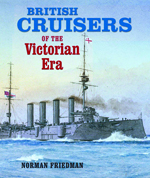
British Cruisers of the Victorian Era
By Norman Friedman
ISBN 978-1-84832-099-4
Seaforth Publishing
www.seaforthpublishing.com
352 pages including Bibliography, Notes, Appendices and ship Data. Extensively illustrated with photographs and drawings.
Reviewed by David Hobbs
THE TERM “cruiser” came into general use in the 1880s to describe ships capable of both long endurance for the protection of Britain’s Imperial trade routes and, in the case of some of the larger examples, acting as a fast wing of the battle fleet. The new description replaced the terms frigate, sloop and corvette which gradually fell out of use with the result that ships described as cruisers covered a very wide range from under 1,000 to over 10,000 tons.
Some of the later armoured ships were more expensive to build and hardly less capable than contemporary battleships. All but one of the ships covered in this book had reciprocating steam engines, some early examples had paddle-wheels but most were propelled by screws; all of them burned coal.
The subject matter includes searching descriptions of why the ships were designed the way they were and how they were operated and employed. The author begins with an introduction that explains how cruisers evolved and how their machinery and armament progressed throughout the nineteenth century. The need for sails to provide cruising endurance in the early ships is also explained. The book is published in Seaforth’s usual large format so that photographs and drawings can be made as large as possible, often filling pages with striking images. When one considers that the newest ship covered was completed more than a century ago the quality of the photographs is generally excellent and they are matched by very detailed drawings by A D Baker III and several reproductions of ‘as fitted’ drawings from the National Maritime Museum Collection at the Brass Foundry in Woolwich.
Seven chapters are devoted to descriptions of the evolving classes of cruiser, beginning with the wooden-hulled ships of the mid-nineteenth century and ending with the fast, armoured ships that were completed in the first years of the twentieth century. Ships built in British yards for export to countries including the United States are included for comparison and a final chapter covers Admiral Fisher’s revolutionary ideas that led to the design of battlecruisers as an intelligence-informed strike force intended to hunt down hostile commerce raiders.
As always, Norman Friedman has carried out extensive research into his subject and has a masterly grasp of detail. The resulting book is written in a lively and informative style and includes a great deal of information about the ships that were deployed in the Australian Station of the Royal Navy and the cruisers that equipped the early RAN, including Encounter, Pioneer and Psyche. The final chapter gives insight into the design of the ultimate expression of the cruiser genre, the battle cruiser, of which Australia was an important example.
Cruisers of the Victorian Era contributes a great deal to our understanding of how warships evolved after the era of sail and is well up to the author’s usual high standards. It must be considered as the primary reference work on the Victorian cruiser force, giving fascinating insight into the ships that formed an important element of the Australian Station for many years as well as the early RAN. It also helps us to understand the thought processes of those who held high command in World War I having been trained in these ships. The book will be an essential acquisition for the collections in naval libraries, of course, but beside its obvious importance, it is also a thoroughly absorbing read and I recommend it highly for everyone with an interest in the generations of warships that preceded our own.



